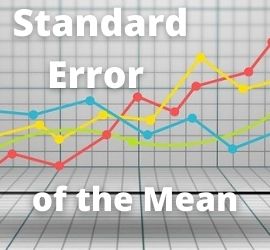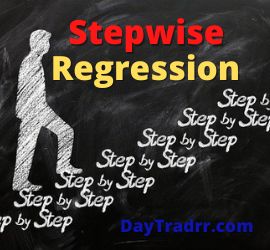Standard Error of the Mean
 The standard error of the mean measures how closely a set of sample data represents an actual population using standard deviation.
The standard error of the mean measures how closely a set of sample data represents an actual population using standard deviation.
SEM is calculated by taking the standard deviation and dividing it by the square root of the sample size. The standard error gives the accuracy of a sample mean by measuring the sample-to-sample variability. The SEM describes how precise the mean of the sample is as an estimate of the true mean of the population. As the size of the sample data grows larger, the SEM decreases versus the standard deviation. In other words, as the sample size increases, the sample mean estimates the true mean of the population with greater precision. In contrast, increasing the sample size does not make the standard deviation necessarily larger or smaller. However, it becomes a more accurate estimate of the population standard deviation.
When gathering data for scientific or statistical purposes, the standard error of the mean can help determine how closely a set of data represents that actual population. By verifying the accuracy of the sample, you know that the clinical study is accurate as well. The standard error of the mean is a method used to determine the differences between more than one sample of data. It measures the accuracy with which sample data represents a population using standard deviation. In statistics, the standard deviation is a measure of how spread out numbers are. The arithmetic mean refers to the average of the numbers.
Standard Error of the Mean – A Closer Look
Standard error functions are used to validate the accuracy of a sample of multiple samples by analyzing the deviations within the means. You can use the standard deviation of the mean to describe how precise the mean of the sample is versus the true mean of the population. As the size of the sample increases, the mean of the population is known with greater accuracy. Also, the smaller the standard error, the more representative the sample will be of the overall population.
For example, if you measure the weight of a large sample of women, their weights could range from 90 to 200 pounds. However, if you look at the mean of the sample data, the samples will only vary by a few pounds. You can then use the standard error of the mean to determine how much the weight varies from the mean.
Both the standard deviation and the standard error of the mean measure variability.
- Standard deviation – The calculation for this statistic compares each observation in a dataset to the mean. Consequently, the standard deviation assesses how data points spread out around the mean.
- The standard error of the mean – The standard error of the mean also measures variability. However, it measures the variability of sample means in a sampling distribution of means.
When you have a sample and calculate its mean, you know that it won’t equal the population mean exactly. Sampling error is the difference between the sample and population mean. When using a sample to estimate the population, you want to know how wrong the sample estimate is likely to be. Specifically, you’re hoping that the sampling error is small. You want your sample mean to be close to the population parameter. (Source: statisticsbyjim.com)
Interpreting the Standard Error of the Mean
Interpreting standard deviation correctly helps to understand the standard error of the mean. The value for the standard deviation indicates the standard or typical distance that an observation falls from the sample mean using the original data units. Larger values correspond with broader distributions. They signify that data points are likely to fall farther from the sample mean. For the standard error of the mean, the value indicates how far sample means are likely to fall from the population mean using the original measurement units. Again, larger values correspond to wider distributions. (Source: ibid)
Standard Error of the Mean Formula
The equation for the standard error of the mean is as follows:

- The numerator (σ) is the sample standard deviation, which represents the variability present in the data.
- The denominator is the square root of the sample size (N), which is an adjustment for the amount of data.
Sample Size – Why Bigger is Better
In statistics, you commonly hear that larger sample sizes are better. The reason becomes apparent when you understand how to calculate the standard error of the mean. Imagine starting a study but then increasing the sample size. The numerator won’t change much because the variability in the underlying population is constant. However, the denominator increases because it contains the larger sample size. The result is that the standard error of the mean declines as the sample size increases. This is because the denominator is the square root of the sample size. So, for example, by quadrupling the sample size, you cut the standard error in half. The SEM equation illustrates how larger samples produce more precise estimates.
Standard Error and Standard Deviation in Finance
In finance, consider the mean or average daily return on an asset:
- The standard error of the mean for the daily return of an asset measures the accuracy of the sample mean. It can then be used as an estimate of the long-running, persistent mean daily return of the asset.
- The standard deviation of the return measures deviations of individual returns from the mean. Thus standard deviation is a measure of volatility and can be used as a risk measure for an investment.
Assets with greater day-to-day price movements have a higher standard deviation than assets with lesser day-to-day movements. As a result, higher deviation correllates to higher volatility. Assuming a normal distribution, around 68% of daily price changes are within one standard deviation of the mean. Approximately 95% of daily price changes fall within two standard deviations of the mean.
Example
Take the example of stock XYZ Co. for the tenure of 25 years. The stock delivered a mean dollar return of $65. The stock delivered the returns with a standard deviation of $3. Calculation for the standard error on the mean returns offered by the stock XYZ Co are as follows:
Calculation:
- Standard Deviation (σ) = $3
- Number of Years (n) = 25
- Mean Dollar Return = $65
- σ͞x = σ/√n
- = $3/√25
- = $3/ 5
- σ͞x =$0.60
- Standard Error = $0.60
Therefore, the investment offers a dollar standard error of the mean of $0.60 to the investor. This is when holding the position in the stock XYZ Co for 25 years. If the stock is held for a longer investment horizon, then the standard error of the mean reduces significantly. Greater sample size means less error. In this example the greater sample size is represented by a longer holding period.
Standard Error of the Mean – Relevance
The standard error tends to be high if the sample size for the analysis is small. A sample is always taken from a larger population, which comprises a larger size of variables. It always helps the statistician to determine the credibility of the sample mean concerning the population mean.
A large standard error indicates that the sample is not uniform concerning the population mean. This means there is a large variation in the sample concerning the population. Similarly, a small standard error indicates that the sample is uniform concerning the population mean. As a result, there is only small variation in the sample concerning the population.
It should not be confused with the standard deviation. The standard deviation is calculated for the entire population. The standard error, on the other hand, is determined for the sample mean.
Up Next: What is a Stop Limit Order?
 A stop-limit order is an order to buy or sell a stock combining the features of a stop order and a limit order to help traders control risk.
A stop-limit order is an order to buy or sell a stock combining the features of a stop order and a limit order to help traders control risk.
The order provides conditional trade instructions over a set timeframe combining the features of a stop and a limit order. These instructions are used to mitigate risk and provide greater control to the trader. Limit orders instruct a broker to either buy or sell a specified number of shares at a given price or better. Stop-on-quote orders instruct a broker to either buy or sell a security after its price has moved past a specified point.
Stop-limit orders trigger a limit order once the stock reaches, or breaks through, a specified stop price. It consists of two price points, the stop price, and the limit price. The stop price is the price that activates the limit order and is based on the last trade price. The limit price identifies the price range required to execute the order once it is triggered. There is no guarantee that a stop-limit order, once triggered, will result in order execution. It is a useful tool when trading securities. However, there are still risks involved. A stop-limit order doesn’t guarantee that any trade will occur if the specified prices are not properly met.




